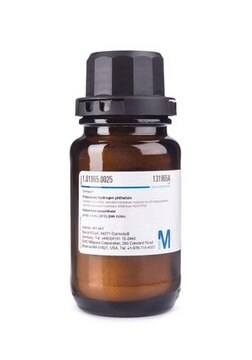P1088
Potassium phthalate monobasic
BioXtra, ≥99.95%
Sinónimos:
Potassium phthalate monobasic, KHP, Phthalic acid monopotassium salt, Potassium biphthalate, Potassium hydrogen phthalate
About This Item
Productos recomendados
Línea del producto
BioXtra
Nivel de calidad
Ensayo
≥99.95%
Formulario
powder or crystals
impurezas
<0.005% Insoluble matter
<0.005% Phosphorus (P)
pH
4
mp
295-300 °C (dec.) (lit.)
trazas de anión
chloride (Cl-): <0.003%
sulfur compounds (as SO42-): ≤0.002%
trazas de catión
Al: <0.0005%
Ca: <0.005%
Cu: <0.0005%
Fe: <0.0005%
Mg: <0.0005%
NH4+: <0.05%
Na: <0.005%
Pb: <0.001%
Zn: <0.0005%
cadena SMILES
[K+].OC(=O)c1ccccc1C([O-])=O
InChI
1S/C8H6O4.K/c9-7(10)5-3-1-2-4-6(5)8(11)12;/h1-4H,(H,9,10)(H,11,12);/q;+1/p-1
Clave InChI
IWZKICVEHNUQTL-UHFFFAOYSA-M
¿Está buscando productos similares? Visita Guía de comparación de productos
Descripción general
Aplicación
Características y beneficios
- Long-term stability
- Exhibits dielectric properties
Código de clase de almacenamiento
11 - Combustible Solids
Clase de riesgo para el agua (WGK)
WGK 1
Punto de inflamabilidad (°F)
387.1 °F - Pensky-Martens closed cup
Punto de inflamabilidad (°C)
197.3 °C - Pensky-Martens closed cup
Equipo de protección personal
Eyeshields, Gloves, type N95 (US)
Elija entre una de las versiones más recientes:
¿Ya tiene este producto?
Encuentre la documentación para los productos que ha comprado recientemente en la Biblioteca de documentos.
Los clientes también vieron
Nuestro equipo de científicos tiene experiencia en todas las áreas de investigación: Ciencias de la vida, Ciencia de los materiales, Síntesis química, Cromatografía, Analítica y muchas otras.
Póngase en contacto con el Servicio técnico




